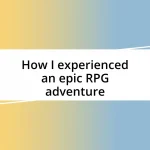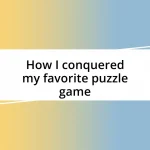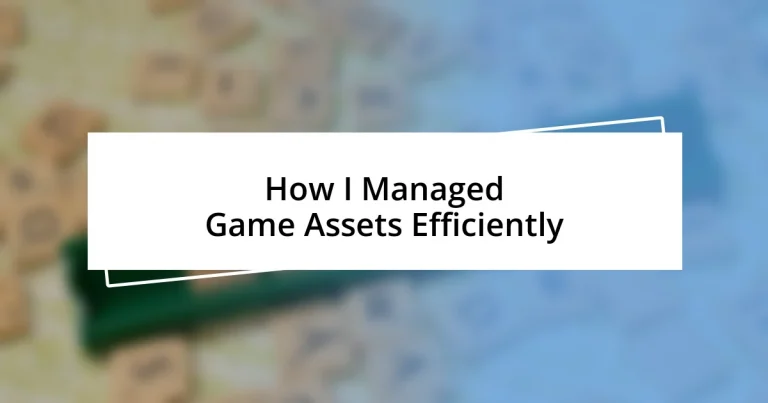Key takeaways:
- Implementing a centralized and structured tagging system significantly improves asset retrieval speed and enhances team collaboration.
- Adopting version control, like Git, reduces anxiety from asset management, enables tracking of changes, and fosters greater teamwork during collaborative projects.
- Regular audits and organized asset libraries not only streamline workflow but encourage creativity and ownership among team members.
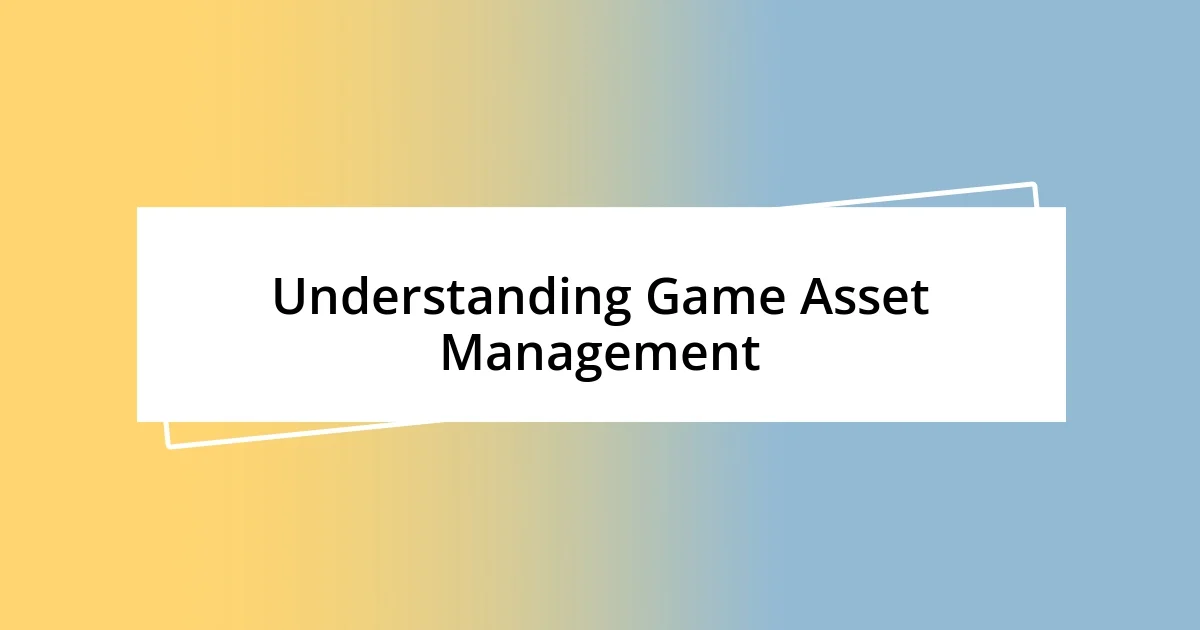
Understanding Game Asset Management
Game asset management is an intricate dance of organization and creativity. I often think back to when I first tackled managing assets for a game project. I was overwhelmed by the sheer volume of textures, models, and sounds; it felt chaotic. But I soon learned that keeping everything in a centralized, well-structured library could transform that chaos into harmony.
When I implemented a tagging system for our assets, the difference was astounding. It allowed my team and me to find exactly what we needed at lightning speed. Have you ever experienced the frustration of searching for that one perfect sound effect among hundreds? I know I have! That system not only enhanced our workflow but also ignited a collaborative spirit—everyone was on the same page, pointing out hidden gems that might have otherwise been overlooked.
Embracing version control became another vital aspect of my game asset management journey. I vividly recall losing hours of work because an old asset had been replaced without proper documentation. That moment taught me the importance of tracking changes. It’s like having a safety net—one that reminds me and my team that our creativity can thrive even when things get chaotic.
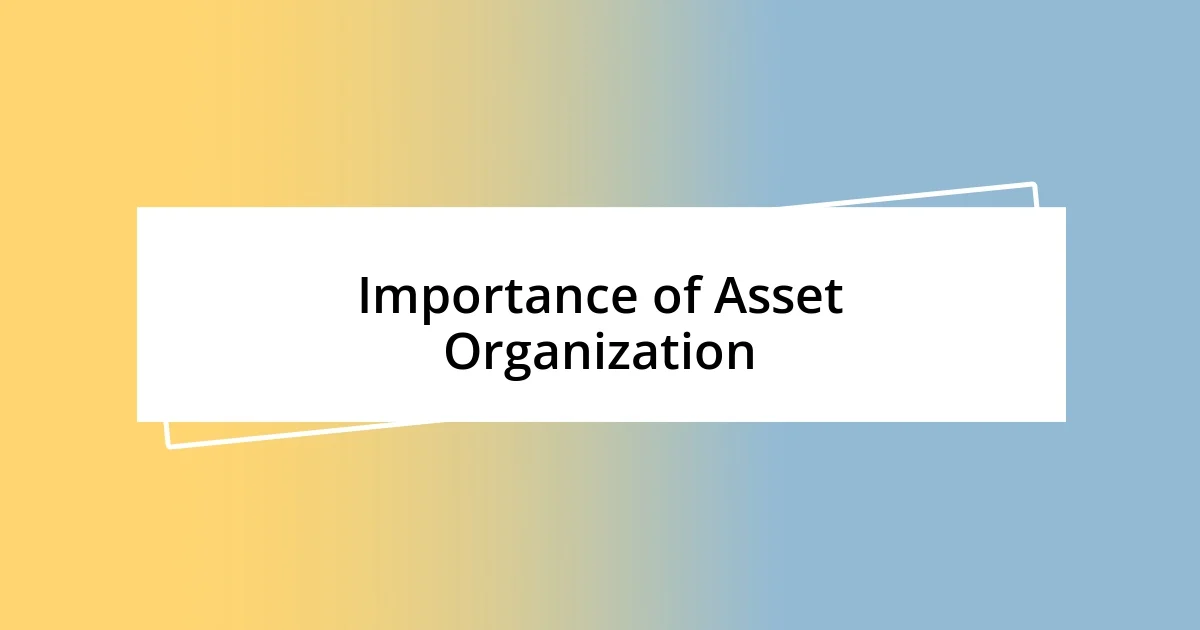
Importance of Asset Organization
The organization of game assets is not merely a matter of tidiness; it’s the backbone of a streamlined production process. I remember a time when our project’s deadlines were looming, and chaos reigned supreme. Some team members were struggling to find crucial assets while others were duplicating work. The stress was palpable. A solid organizational system not only alleviated that pressure but fostered a sense of teamwork where creativity could flourish.
Here are some reasons why asset organization is vital:
- Efficiency Boost: Quickly locating assets saves time and allows for more focus on creativity.
- Reduced Redundancy: A clear structure minimizes the risk of duplication, ensuring that everyone uses the most current assets.
- Enhanced Collaboration: A well-organized library encourages team members to share and build upon each other’s work.
- Streamlined Updates: When assets are properly tagged, updating or replacing them becomes seamless and less error-prone.
- Leveraged Creativity: A stress-free environment where all team members can easily find resources enables them to think outside the box.
When everything is in its place, it’s easier to collaborate and bounce ideas off one another, which is what game development is all about!
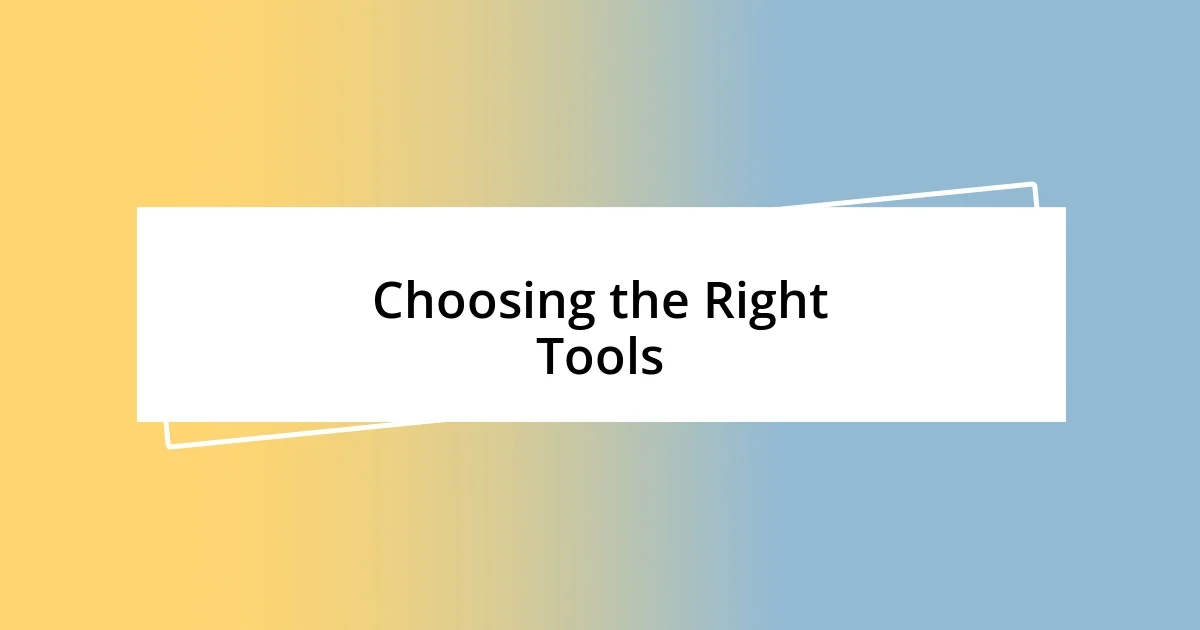
Choosing the Right Tools
Choosing the right tools for managing game assets can significantly influence your workflow. I recall experimenting with various software solutions, feeling like a kid in a candy store. Some tools promised efficiency but fell short due to their complex interfaces, leaving me frustrated. Eventually, I gravitated towards user-friendly platforms that were not only effective but intuitive. This experience taught me that ease of use is just as important as functionality.
The ultimate decision revolves around your specific needs and team dynamics. I remember choosing a tool based on its collaboration features, which turned out to be a game-changer. It fostered real-time updates and communication among my team, making our workflow smoother. Have you ever faced challenges with team miscommunication? I have, and using the right tools to bridge that gap made a world of difference.
To simplify the comparison of different tools, I’ve created a table that outlines key features and considerations:
| Tool | Key Features | Best For |
|---|---|---|
| Tool A | User-Friendly Interface, Tagging System, Collaboration Tools | Small Teams |
| Tool B | Advanced Version Control, Asset Tracking | Large Projects |
| Tool C | Integration with Other Software, Customizable | Flexible Workflows |
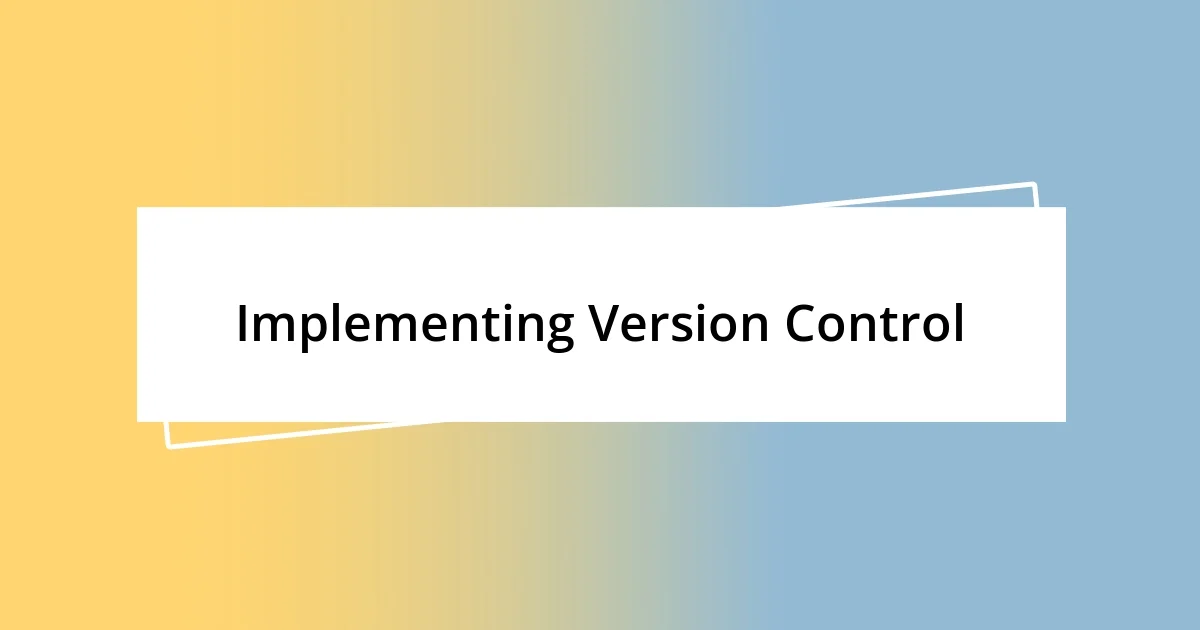
Implementing Version Control
Implementing version control for game assets has been a transformative experience for me. In one particular project, we faced a minor disaster when an outdated asset was accidentally used in a build. I thought, “How did I let this happen?” That moment highlighted the urgent need for a robust version control system. By adopting a system like Git, I was able to track changes, revert to previous versions, and ensure that everyone on the team was working with the most current assets.
I’ve found that the emotional weight of managing game assets can really be alleviated by version control. There’s something reassuring about knowing that every change is documented – it reduces anxiety when experimenting with new ideas. Remember that sinking feeling when you think you’ve lost progress? With a solid version control system, I’ve experienced freedom in creativity, knowing that I can always return to a stable version if things go awry.
One of the most impactful aspects of version control is its role in enhancing teamwork. I vividly recall a situation where multiple team members were working on similar character designs independently. Version control not only streamlined our collaboration but allowed us to merge our ideas seamlessly, creating something far more vibrant than I could have imagined on my own. Wouldn’t it be amazing if collaboration could always feel this effortless? I truly believe that implementing version control laid the groundwork for an even more cohesive and dynamic development environment.
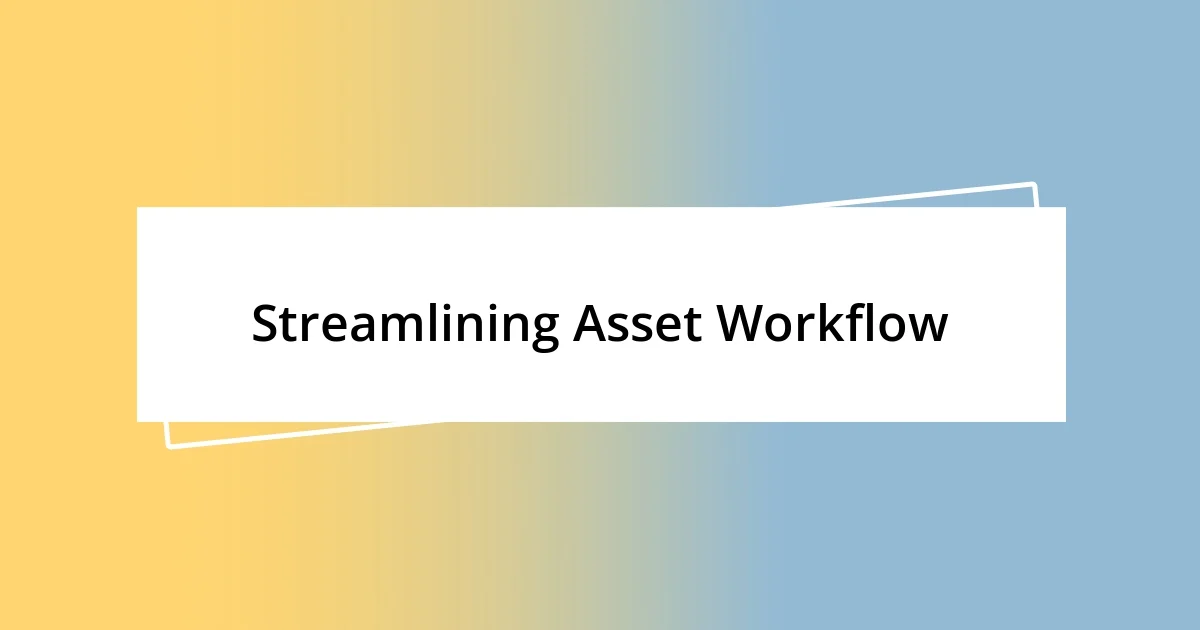
Streamlining Asset Workflow
Streamlining the asset workflow became a journey of discovery for me. I recall a project where our team was drowning in a sea of disorganized files. To tackle this, I initiated a standardized naming convention and folder structure that everyone adhered to. This simple change made locating assets effortless and saved countless hours of frustration. Have you ever felt lost in a cluttered workspace? I know I have, and establishing order was incredibly liberating.
I also learned the value of automation in asset management. In one instance, integrating automated asset pipelines transformed my daily routine. Automatic tagging and categorization not only removed tedious manual tasks but also reduced human error. It was such a relief to let the software handle repetitive chores while I could focus my energy on creative pursuits. How much time do you think you could regain by automating your workflow? For me, this shift meant more room for innovation and less time spent on mundane tasks.
Communication played a vital role in streamlining our workflow, too. By implementing daily stand-up meetings, we maintained alignment on progress and challenges. I vividly remember a team member expressing frustration over asset access issues; we quickly resolved it there and then. Those quick check-ins fostered a sense of camaraderie and accountability, making us all more invested in the project. Don’t you think that a little communication can go a long way? It sure has for us, turning a chaotic workflow into a symphony of collaboration.
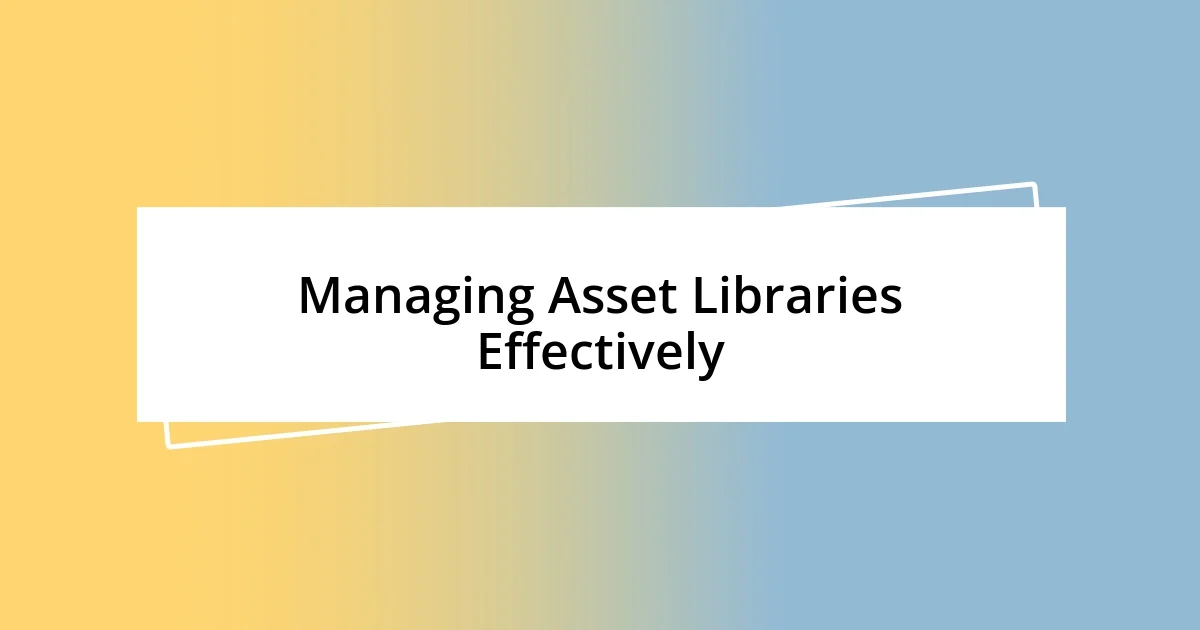
Managing Asset Libraries Effectively
Managing an asset library effectively is much like curating a digital museum. I once found myself overwhelmed by a cluttered library where assets were lost in the chaos. By implementing clear categories and tags, I could easily locate the right assets when I needed them. Have you ever spent an hour searching for a file only to realize it was mislabeled? Organizing my assets not only reduced stress but also unleashed a more focused creative energy.
Regular audits of the asset library became a game changer for me. I dedicated time each month to evaluate what assets were still relevant and which ones could be archived or deleted. This practice not only kept the library sleek but also made room for new assets and ideas. I remember the satisfaction of seeing files that hadn’t been used in ages get purged, making space for fresh inspiration. Could you imagine the clarity that comes from knowing exactly what you have at your fingertips?
Collaboration also plays a crucial role in managing an asset library. In one memorable project, I set up a shared repository where everyone on the team could contribute and access assets freely. It was astonishing how many innovative ideas emerged from this openness. I often wondered, “What treasures are waiting to be discovered?” This approach not only enriched our library but also fostered a sense of ownership among team members. I truly believe that when everyone has a stake in the asset library, creativity can flourish beyond expectations.

Case Studies of Successful Management
One standout case in my experience involved a high-profile game launch where mismanagement of assets could have derailed everything. A colleague introduced a “single source of truth” concept—essentially a centralized database for all game assets. This move was revolutionary; it ensured that everyone accessed the same versions of files, eliminating copy discrepancies. Remember the cringe-worthy moments when an outdated asset would sneak into a presentation? I certainly do, and that centralized approach put an end to those mishaps, reinforcing team trust and collaboration.
Another compelling example was during a multiplayer game project when we faced severe performance issues due to oversized asset files. To tackle this, I initiated a collaborative effort to optimize assets without sacrificing quality. We held team workshops where each artist shared techniques on creating efficient textures and models. This collective brainstorming fostered not just innovation but also camaraderie—it’s exciting to see a team rally around a shared problem, isn’t it? The result? A smoother game experience and heightened morale, as we all felt like we had a hand in the solution.
Lastly, I recall a time when clear communication channels transformed our asset review process. Our team transitioned from lengthy emails to an open chat platform, where feedback flowed freely in real-time. One day, I witnessed an artist and a developer quickly hash out asset requirements on the spot, drastically cutting down the review timeline. Have you ever experienced that “aha!” moment where everything just clicks? That’s what happened for us. The atmosphere shifted; we became more agile, responsive, and, honestly, happier working together. It’s amazing what a little infrastructure and transparency can do, right?








